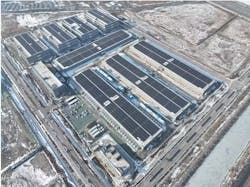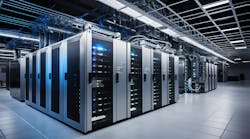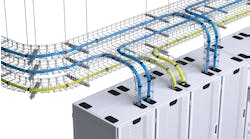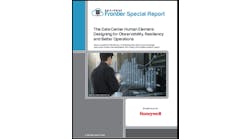This story originally appeared at Data Center Frontier's sibling site, Microgrid Knowledge. It has been lightly curated for DCF's audience.
Tencent, one of China’s largest technology companies, has commissioned a new microgrid at its High-Tech Cloud Data Center in Tianjin.
With a total installed capacity of 10.54 MW, it is expected the microgrid will produce 12 million kWh of electricity per year – equivalent to the power consumption of 6,000 households – according to a statement from the company.
Data centers are notoriously power hungry, and that appetite is increasing exponentially as artificial intelligence (AI)-driven programs grow in popularity. AI applications require considerably more computing power than traditional computer programs.
Increasingly, data center operators are turning to microgrids to improve electric resilience, lower energy costs and achieve sustainability goals.
Data Centers That Double as Power Plants
To power its operations, Tencent, an internet, cloud computing and technology company that is perhaps best known outside of China for its video games, e-commerce and social media platforms, has been installing photovoltaic panels on rooftops at its facilities across the country for several years.
The result is a total installed capacity of more than 50 MW as of 2023 and “data centers that double as power plants,” according to the company.
In addition to the large rooftop solar array, the Tianjin microgrid includes a battery energy storage system to manage the ebbs and flows inherent to solar energy generation.
An AI- and machine learning-enabled control system allows the company to “process data from multiple energy sources and predict future electricity demand and generation,” according to the company.
Tencent has committed to becoming carbon neutral by 2030 and expects to purchase more than 1.3 billion kWh of renewable energy in 2024.
“Renewable energy accounts for 54% of the annual electricity consumption of Tencent’s own data centers as of today, and more than 70% of [its] self-built campuses use green power,” the company said.
Data Giants Demand Microgrid Flexibility
While Tencent has focused on solar microgrids, other data center players are exploring microgrids powered by different types of lower emissions or zero emissions fuels.
Microsoft has demonstrated microgrids powered by hydrogen fuel cells in Wyoming and renewable natural gas in California.
In the case of Wyoming, Caterpillar and Ballard were just seen by DCF proving out hydrogen fuel cells for battery backup at the Microsoft cloud data center site in Cheyenne.
Caterpillar led the project amid icy conditions, proving out system performance in challenging environments, while providing overall system integration, power electronics, and microgrid controls that form the central structure of the hydrogen power solution.
The project simulated a 48-hour backup power event at the campus, where a hydrogen fuel cell was integrated into a data center's electrical plant to support its critical load. The demonstration validated the hydrogen fuel cell power system's performance at 6,086 ft (1,855 m) above sea level and in below-freezing conditions.
The partners said the demonstration provided valuable insights into the capabilities of fuel cell systems to power multi-megawatt data centers, ensuring an uninterrupted power supply to meet 99.999% uptime requirements.
In the demonstration, a Caterpillar Microgrid Controller was used to operate two of the company's Cat® Power Grid Stabilization (PGS) 1260 battery energy storage systems, along with the 1.5 MW hydrogen fuel cell.
Meanwhile, Vertiv recently commissioned a microgrid powered by solar, hydrogen fuel cells and a battery energy storage system. Vertiv launched the microgrid to support its new Customer Experience Center in Delaware, Ohio, just north of Columbus.
The 1-MW microgrid, which was announced at the facility’s grand opening and is now operational, was designed to show data centers how they can address the electrical grid capacity and availability challenges they face as the world moves more and more online.
The installation includes a 1-MW alternating current (AC) solar array and a 400-kW hydrogen fuel cell, as well as a 1-MW lithium-ion battery energy storage system and microgrid controller.
Vertiv partnered with American Electric Power on the microgrid, which will serve as a proof of concept, testing how the microgrid works with Vertiv’s data center infrastructure technologies.
Among the key metrics the company will be measuring are reliability, backup power duration and how well the microgrid responds in a variety of operating conditions.
Tencent Cloud
Tencent Cloud is China’s leading cloud service provider offering global, secure, reliable and high-performance cloud compute services. The company also operates a global infrastructure with 70 availability zones across 27 regions, including China and Russia.
Tencent’s social media and entertainment eco-system reaches over a billion users in China and Asia.
Benzinga has reported that Tencent is currently in the midst of a cloud computing bidding war with cloud rival Alibaba, as the companies race to support 'Palworld' -- a hit game described as 'Pokémon with guns' -- with cloud services.
Track news on new data center microgrid projects. Subscribe to the free Microgrid Knowledge Newsletter and view recent issues.
Keep pace with the fast-moving world of data centers and cloud computing by connecting with Data Center Frontier on LinkedIn, following us on X/Twitter and Facebook, and signing up for our weekly newsletters using the form below.

Kathy Hitchens
Kathy Hitchens has been writing professionally for more than 30 years. She focuses on the renewable energy, electric vehicle, utility, data center, and financial services sectors. Kathy has a BFA from the University of Arizona and a MBA from the University of Denver.





